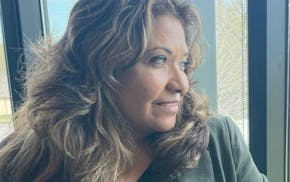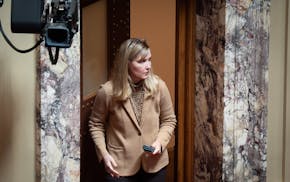Her emotions flared just a bit when Thera Witte described how she became the first person in the Twin Cities to receive the COVID-19 vaccine.
She remembered cheering co-workers as she walked to get her shot on that December morning, and the sense that the pandemic's end finally was coming into view.
One year later, more than 1 million Minnesotans remain unvaccinated as the much more transmissible omicron variant threatens to drive an unprecedented spike in cases. It's left Minnesota's vaccine pioneers — the health care workers that were the first to get immunized across the state — with a searing sense of uncertainty about what's coming in the new year.
"This time last year, if you would have said this is where we'd be, I'd say: 'Not a chance. We're going to be in a better spot,'" said Witte, a nurse who works with COVID patients at the Minneapolis VA Medical Center. "But you have those feelings of hope, and then some hopelessness. ... When are we going to see this end?"
Witte received her first vaccine dose on Dec. 15, 2020. One day earlier, nurse practitioner Andrea Athmann-Luksik of Cass Lake Hospital became the first Minnesotan to be vaccinated with a ceremony organized by the Indian Health Service, her employer in northern Minnesota.
This coming week marks one year since both women received second doses to complete their vaccination series. Last January's optimism isn't completely gone, Athmann-Luksik said, but it's accompanied by a sober understanding that patients and the health care system still must keep managing through the pandemic.
"That's where that fatigue comes," she said. The feeling is: "Oh, my goodness, how many more rounds of this are we going to have and how much more can we support? I think it speaks to how important it is to vaccinate."
In the first year of COVID-19 vaccines, more than 8.3 million total doses were administered in Minnesota, according to the state Health Department.
Federal data show that about 65% of state residents, nearly 3.7 million people, completed their vaccination series. Among the fully vaccinated, nearly half have received a booster dose.
Those are huge numbers, yet the tally falls short of what Dr. Casey Clements was expecting when he became one of the first six people vaccinated at Mayo Clinic.
Clements was selected for the ceremony in part because he diagnosed the clinic's first COVID-19 case in Rochester. He also voiced questions internally about the safety and effectiveness of the vaccines before they were authorized for use.
The results from the initial vaccine studies were more than convincing, Clements said, yet he was glad to spotlight his initial concerns so patients would know that doctors weren't just passively endorsing immunizations. One year later, Clements said he fears the high number of vaccine holdouts means the country just hasn't had enough thoughtful discussion about the risks and benefits.
"I think people have dug in their heels because we haven't had a healthy conversation about the vaccines, how they work and their safety," he said. "Instead, we're shouting at each other across an aisle. ... It's not how you change hearts and minds. And I'm very, very surprised at the number of people that have chosen not to [get vaccinated], at this point, given what I know about the safety and efficacy outcomes."
Dr. Dan Anderson received his shot during an event at Abbott Northwestern Hospital in Minneapolis to showcase the medical center's first recipients. The optimism of that day is now tempered by caution, said Anderson, an infectious disease specialist. Even though the vaccine is working, the COVID-19 waves haven't stopped coming and health care workers are tired.
"You run a race and if you know where the end is, it's easier to prepare," he said. "But if the end keeps shifting, that makes it more difficult. You can't sprint to the finish line because you don't know where the finish line is."
Dr. Sara Spilseth was one of the first 50 vaccinated at Regions Hospital in St. Paul. She says her immunization highlight came months later when she administered vaccine to her 11-year-old daughter Brooke and finally felt like everyone in her family was protected.
In her work with COVID-19 patients, Spilseth said she's spent too much time holding the hands of people dying from COVID-19 to understand why more aren't protecting themselves. The sorrow now extends to non-COVID patients, she said, who struggle to find hospital beds because medical centers all across the Twin Cities are just too full.
"We're using a lot of resources and patients are getting the care that they need but, gosh, I don't know how much longer we can do this," Spilseth said.
Health care workers are resilient, said Nick Hetchler, a medical interpreter who was one of the first five vaccinated during a ceremony at Hennepin Healthcare in Minneapolis. The past year has generated countless stories, he said, of patients who were helped by the vaccine — including Hetchler, who suffered a breakthrough infection in September, just before he became eligible for a booster.
"I'm a severe asthmatic. I've been hospitalized because of asthma a few times," he said. "The fact that I was able to get COVID and survive without being hospitalized ... I credit the vaccine with that."
In late 2020, the vaccine brightened otherwise dark days as Minnesota was just beginning to come out of its biggest COVID-19 surge thus far, recalled Dr. Shirlee Xie, another of the first five recipients at Hennepin Healthcare.
There's hope in knowing that the majority of Minnesotans have been vaccinated, Xie said, but one of the fears with omicron is that "more health care workers are going to get sick and so what does that mean for who's left to take care of patients in the hospital?"
Case counts are skyrocketing where the new variant has spread, even as evidence mounts that a smaller proportion of those infected require hospitalization. Xie fears the net result here will be an even greater burden on medical centers.
"When you look at the big picture," she said, "I think there is still a lot of dread."
When he administered the first COVID-19 vaccine at M Health Fairview in Minneapolis, Dr. Andrew Olson's primary thought was "this thing's going to end." That remains true, Olson said, but there's uncertainty with timeline and what the conclusion will look like — just as there is with the latest variant.
"We're really worried about what's going to happen with omicron," he said. "If you have these almost vertical lines of case counts [jumping] in a geographic area, even if you have a smaller proportion of those people being hospitalized, a small proportion of a very large number is unfortunately a very large number. We simply don't know yet — we have to wait and see."

Meet the affordable housing champion fighting for St. Paul's West Side

Minnesota Senate panel convenes ethics hearing into Sen. Mitchell's burglary arrest
St. Paul police: officers shoot, kill woman who pointed gun at them after suicide call

Witnesses in Feeding Our Future trial testify they saw no meals served

